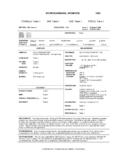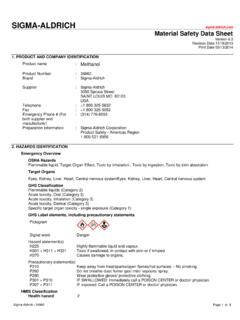Transcription of HYDROCARBONS, HALOGENATED 1003
1 HYDROCARBONS, HALOGENATED 1003. table 1 MW: table 2 CAS: table 1 RTECS: table 1. METHOD: 1003, Issue 3 EVALUATION: PARTIAL Issue 1: 15 February 1984. Issue 3: 15 March 2003. OSHA : See table 1 PROPERTIES: See table 2. NIOSH: See table 1. ACGIH: See table 1. COMPOUNDS: See table 1. (synonyms). SAMPLING MEASUREMENT. SAMPLER: SOLID SORBENT TUBE TECHNIQUE: GAS CHROMATOGRAPHY, FID. (coconut shell charcoal, 100 mg/50 mg). (Lot # 2000) ANALYTE: compounds listed above FLOW RATE: to L/min DESORPTION: 1 mL CS2 , stand 30 min VOL-MIN: table 3 INJECTION. -MAX: table 3 VOLUME: 1 L.
2 SHIPMENT: Routine TEMPERATURE: Group A: Inj = 200 C, Det = 250 C ;. 35 C (3 min) to 150 C. SAMPLE (8 C/min). STABILITY: 30 days for all analytes Group B: Inj = 225 C, Det = 250 C ;. 35 C (3 min) to 190 C. BLANKS: 2 to 10 field blanks per set (8 C/min). CARRIER GAS: He, (Group A: mL/min). (Group B: mL/min). ACCURACY. COLUMN: Group A: capillary, fused silica, 30 m x RANGE STUDIED: see EVALUATION OF METHOD [1] ID; m film diphenyl/ dimethyl polysiloxane, Rtx or equivalent. Group B: capillary, fused silica, 30 m x - mm BIAS: see EVALUATION OF METHOD [1].
3 ID; 3- m film 35% diphenyl- 65%. dimethyl polysiloxane, Rtx -35 or OVERALL. equivalent. PRECISION ( r T ): see EVALUATION OF METHOD [1]. CALIBRATION: standard solutions of analytes in CS2. ACCURACY: see EVALUATION OF METHOD [1]. RANGE: see Evaluation of Method ESTIMATED LOD: table 4. PRECISION ( r ): table 4. APPLICABILITY: See table 3 for working ranges. This method can be used for simultaneous determination of two or more of the analytes of interest either by use of both of the capillary columns listed above or by modifying the analytical parameters ( , temperature program) of the method.
4 High humidity during sampling will decrease total breakthrough volume. INTERFERENCES: None identified but as the number of different analytes sampled increases so does the chance for interferences. The choice of capillary column or analytical parameters may be modified to circumvent such interferences. OTHER METHODS: This method is an update for NMAM Method 1003 (Issue 1, 2/15/84) [2]. Trichloroethylene, NIOSH. Method 1022, was included in this method update [3]. Method improvements include higher recoveries at lower sample recovery levels, lower LOD and LOQ values, incorporation of capillary column chromatography, and acceptable recoveries in a 30 day storage stability study.
5 NIOSH Manual of Analytical Methods (NMAM), Fourth Edition HYD RO CAR BO NS, H ALO GE NAT ED: M ETH OD 1003, Issue 3, dated 1 5 Ma rch 2003 Page 2 o f 7. REAGENTS: EQUIPMENT: 1. Ca rbon disulfide, chrom atog raph ic qua lity.* 1. Sampler: glass tube, 7 cm long, 6-mm OD, 2. An alyte s, reagent grade quality. 4-mm ID, flame-sealed ends with plastic caps, 3. Nitrogen or helium, purified. containing two sections of 20/40 mesh 4. Hydrogen, prepurified. activated (600 C) coconut shell charcoal 5. Air, filtered. (front = 100 mg; back = 50 mg) separated by a 2-mm urethane foam plug.
6 A silylated glass wool plug precedes the front section and a 3-mm urethane foam plug follows the back sec tion. Pre ssu re drop a cross th e tube at 1. * See SPECIAL PRECAUTIONS. L/m in airflow m ust be less than k Pa. Tubes are comm ercially available ( , SKC. #226-01 , Lot# 2000 or equ ivalent). 2. Personal sampling pump, to L/min, with flexible connecting tubing. 3. Gas chromatograph, FID, integrator and colum ns (see pa ge1003 -1). 4. Via ls, 2-m L, glass, P TFE -line d septum crim p caps. 5. Volumetric flasks, 10-mL. 6. Syringes, 10- L to 1-mL, readable to L.
7 7. Pipet, 1-mL, with pipet bulb. SPECIAL PRECAUTIONS: Carbon disulfide is toxic and a serious fire and explosion hazard (flash point = !30 C). W ork with it only in a hood. Several of the analytes are suspect carcinogens ( table 1). W ear appropriate protection clothing and work with these compounds in a well ventilated hoo d. SAMPLING: 1. Calibrate each personal sampling pump with a representative sampler in line. 2. Break the ends of the sampler imm ediately before sampling. Attach sampler to personal sampling pump with flexible tubing. 3. Sam ple at an accurately known flow rate between and L/min for a total sample size between the limits shown in table 2.
8 4. Ca p the sam plers. Pac k secu rely for shipm ent. SAMPLE PREPARATION: 5. Place the front and back sorbent sections of the sampler tube in separate vials. The glass wool plug should be included in the vial containing the front sorbent section. Discard the glass wool and foam plugs. 6. Add mL CS 2 to each vial. C ap each vial. 7. Allow to stand 30 min with occasional agitation. CALIBRATION AND QUALITY CONTRO L: 8. Ca librate daily with at leas t six wo rking standa rds over the appro priate rang e from below the LOD to 10x the LO Q or grea ter if required (see T able 3).
9 A. Add known amounts of neat analyte or calibration stock solution to CS 2 in 10-mL volumetric flasks and dilute to the mark. b. Analyze with samp les and blanks (steps 11 and 12). c. Prepare calibra tion gra ph (p eak area vs. :g analyte). NIOSH Manual of Analytical Methods (NMAM), Fourth Edition HYD RO CAR BO NS, H ALO GE NAT ED: M ETH OD 1003, Issue 3, dated 1 5 Ma rch 2003 Page 3 o f 7. 9. Determine desorption efficiency (DE) at least once for each lot of charcoal used for sampling in the range of interest. Prepare three tubes at each of five concentrations plus three media blanks.
10 A. Rem ove and disca rd back sorbent sec tion of a blank sam pler. b. Inject a known amount (2 to 20 L) of pure analyte, or calibration stock solution, directly onto front sorbent section with a microliter syringe. c. Ca p the tube. Allow to stand overnight. d. Deso rb (steps 5 through 7 ) and analyze together with working standards (steps 11 and 12). e. Prepare a graph of DE vs. g analyte recovered. 10. Analyze three quality control blind spikes and three analyst spikes to insure that the calibration graph and D E graph are in control. MEASUREMENT: 11.











